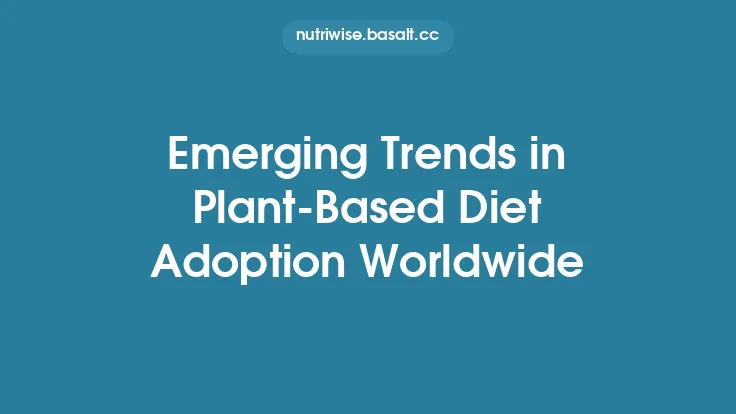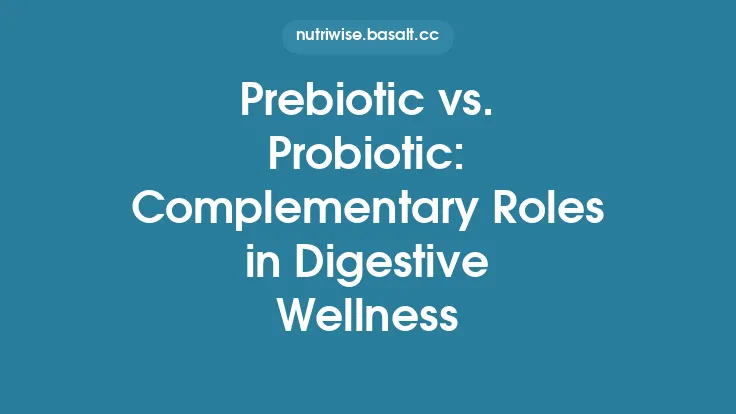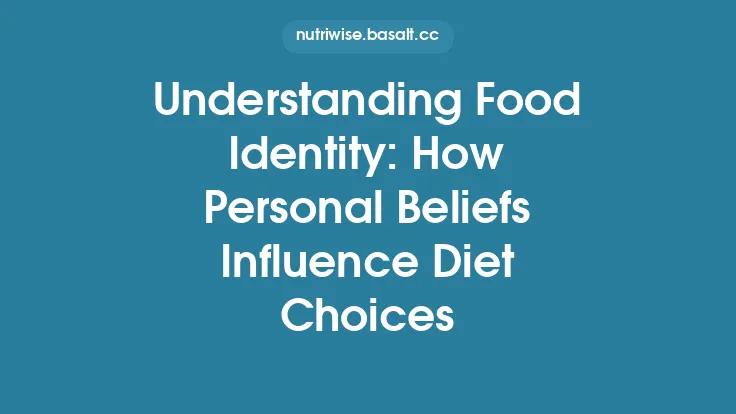Adhering to a dietary plan is rarely a simple matter of willpower; it is deeply rooted in the psychological forces that drive our behavior. Understanding whether those forces arise from within the individual (intrinsic motivation) or are imposed from outside (extrinsic motivation) can illuminate why some people stick to a regimen while others abandon it after a few weeks. This article dissects the two primary motivation types, explores how they operate in the context of diet adherence, and offers evidence‑based strategies for fostering the most durable form of motivation.
Understanding Intrinsic Motivation in Dietary Behavior
Definition and Core Characteristics
Intrinsic motivation refers to engaging in an activity for its inherent satisfaction rather than for an external reward or pressure. In the realm of eating, this means choosing foods or following a dietary pattern because it feels personally meaningful, enjoyable, or aligned with one’s values.
Key Psychological Needs
Self‑Determination Theory (SDT) identifies three universal needs that, when satisfied, nurture intrinsic motivation:
- Autonomy – the sense that one’s eating choices are self‑directed rather than coerced.
- Competence – feeling capable of preparing meals, interpreting nutrition information, and managing hunger cues.
- Relatedness – experiencing a genuine connection to the food culture, community, or personal heritage that makes eating feel socially resonant.
When a diet plan supports these needs, individuals are more likely to internalize the behavior, turning it into a habit that persists even when external incentives fade.
Neurobiological Correlates
Neuroimaging studies have shown that intrinsically motivated actions activate the brain’s reward circuitry—particularly the ventral striatum and medial prefrontal cortex—without reliance on external dopaminergic spikes associated with tangible rewards. This internal reward loop promotes sustained engagement because the brain learns to associate the behavior itself with pleasure.
Examples in Practice
- Curiosity‑Driven Exploration: A person who enjoys experimenting with new recipes discovers a plant‑based diet because cooking becomes a creative outlet.
- Value Alignment: Someone who prioritizes environmental stewardship adopts a low‑meat diet because it aligns with their ecological convictions.
- Skill Mastery: An individual who relishes mastering culinary techniques feels motivated to follow a Mediterranean diet because it offers continual opportunities to refine cooking skills.
Extrinsic Motivation: External Drivers and Their Influence
Definition and Subtypes
Extrinsic motivation involves performing a behavior to obtain an outcome that is separate from the activity itself. In dietary contexts, this can range from tangible rewards (e.g., weight loss, financial incentives) to social pressures (e.g., approval from a partner). SDT further subdivides extrinsic motivation into a continuum:
- External Regulation – behavior is driven by direct rewards or punishments (e.g., “I’ll lose weight to avoid criticism”).
- Introjected Regulation – internalized pressure, such as guilt or anxiety about not meeting standards.
- Identified Regulation – recognizing the personal importance of a behavior (e.g., “I eat low‑sugar foods because I value long‑term health”).
- Integrated Regulation – the behavior is fully assimilated with one’s self‑concept, bordering on intrinsic motivation but still linked to external outcomes.
Effectiveness and Limitations
Extrinsic incentives can jump‑start adherence, especially when an individual lacks prior experience with a dietary pattern. However, reliance on external rewards often leads to a “what’s‑in‑it‑for‑me” mindset that may crumble once the incentive is removed. Moreover, overly controlling external pressures can undermine autonomy, potentially decreasing long‑term commitment.
Empirical Findings
Meta‑analyses of weight‑loss interventions reveal that programs employing modest financial incentives achieve short‑term weight reductions, but the effect size diminishes after the incentive period ends. Conversely, interventions that combine external prompts with autonomy‑supportive counseling tend to produce more durable outcomes.
Self‑Determination Theory and the Continuum of Motivation
SDT provides a comprehensive framework for understanding how motivation can shift along a spectrum from purely extrinsic to fully intrinsic. The theory posits that the quality of motivation—not just its quantity—predicts behavioral persistence.
Motivation Internalization Process
- External Regulation → Introjection: The individual begins to internalize external standards, feeling personal guilt if they deviate.
- Introjection → Identification: The person acknowledges the personal relevance of the diet (e.g., “I want to improve my cholesterol”).
- Identification → Integration: The diet becomes part of the individual’s identity, aligning with broader life goals.
- Integration → Intrinsic Motivation: The activity is performed for its own sake, such as enjoying the flavors and rituals of the diet.
Practical Implications
Designing diet programs that scaffold this internalization—by offering choice, providing competence‑building feedback, and fostering meaningful connections—can transform initially extrinsic motivations into lasting intrinsic drivers.
Assessing Motivation Types in Diet Adherence
Self‑Report Instruments
- Behavioral Regulation in Exercise Questionnaire (BREQ‑2) Adapted for Diet: Measures the degree of external, introjected, identified, integrated, and intrinsic regulation.
- Motivation for Healthy Eating Scale (MHES): Captures autonomy, competence, and relatedness perceptions specific to food choices.
Objective Indicators
- Adherence Consistency: Frequency of meal logging over time; high consistency despite removal of incentives suggests intrinsic motivation.
- Physiological Markers: Stable biomarkers (e.g., fasting glucose) maintained without ongoing external reinforcement can indicate internalized behavior.
Interpretation Guidelines
A profile dominated by identified or integrated regulation often predicts medium‑to‑long‑term adherence, whereas a profile heavy in external regulation predicts rapid dropout once incentives cease.
Practical Strategies to Cultivate Intrinsic Motivation
- Offer Meaningful Choice
- Provide a menu of diet plans rather than a single prescriptive protocol.
- Allow flexibility in meal timing and ingredient swaps to reinforce autonomy.
- Enhance Competence Through Skill Building
- Conduct hands‑on cooking workshops that teach simple, repeatable techniques.
- Use progressive goal‑setting (e.g., mastering a new vegetable preparation each week).
- Foster Relatedness Without Social Pressure
- Create community spaces focused on shared learning rather than competition.
- Encourage storytelling about personal food experiences to deepen emotional connection.
- Connect Eating to Personal Values
- Guide individuals through reflective exercises that link dietary choices to health, environmental, or ethical values.
- Use value‑clarification worksheets to make the abstract importance of nutrition concrete.
- Implement Reflective Feedback Loops
- Encourage regular self‑assessment (e.g., “What did I enjoy about today’s meals?”).
- Provide non‑judgmental data visualizations that highlight progress in health markers, reinforcing competence.
When Extrinsic Incentives Can Be Effective
While intrinsic motivation is the gold standard for durability, extrinsic incentives have a legitimate role in certain contexts:
- Initiation Phase: Small, time‑limited rewards (e.g., a free nutrition consultation after two weeks of logging) can help overcome inertia.
- Behavioral Shaping: For complex dietary changes (e.g., transitioning to a low‑FODMAP diet), stepwise external prompts can scaffold skill acquisition.
- Population‑Level Interventions: Policy tools such as tax rebates for purchasing fruits and vegetables can shift the environment, making healthier choices more attractive.
The key is to pair these incentives with autonomy‑supportive communication, ensuring that the external reward does not eclipse the individual’s sense of volition.
Balancing Intrinsic and Extrinsic Factors for Sustainable Adherence
A hybrid approach acknowledges that most people operate along a motivational continuum rather than at a single point. Effective diet programs therefore:
- Start with External Supports (e.g., reminders, modest incentives) to spark initial engagement.
- Gradually Shift Emphasis toward autonomy‑supportive elements as competence builds.
- Monitor Motivation Profiles regularly, adjusting the balance of external and internal cues to prevent over‑reliance on any single driver.
By intentionally designing this transition, practitioners can reduce the risk of “motivation crash” when external rewards are withdrawn.
Common Pitfalls and How to Mitigate Them
| Pitfall | Why It Undermines Motivation | Mitigation |
|---|---|---|
| Over‑controlling language (“You must eat this”) | Triggers resistance, diminishes autonomy | Use collaborative phrasing (“Let’s explore options together”) |
| Reward dependency (e.g., only logging when a prize is offered) | Weakens intrinsic interest | Pair rewards with skill‑building tasks that foster competence |
| Neglecting personal values (one‑size‑fits‑all diet) | Reduces relevance, hampers identification | Conduct value‑clarification sessions early in the program |
| Lack of feedback (no data on progress) | Erodes sense of competence | Provide regular, easy‑to‑interpret health metrics |
| Ignoring taste preferences | Leads to perceived sacrifice, increasing introjection | Offer flavor‑profile customization and recipe libraries |
Future Directions in Research on Motivation and Diet
- Neurobehavioral Mapping – Longitudinal fMRI studies tracking changes in reward circuitry as individuals transition from extrinsic to intrinsic motivation.
- Digital Personalization Algorithms – Machine‑learning models that adapt dietary recommendations based on real‑time motivation assessments (e.g., sentiment analysis of food logs).
- Cross‑Cultural Validation of SDT Constructs – Examining how autonomy, competence, and relatedness manifest in collectivist versus individualist societies and their impact on diet adherence.
- Integration with Wearable Technology – Using physiological signals (e.g., heart‑rate variability) to detect motivational states and deliver timely autonomy‑supportive prompts.
- Policy‑Level Experiments – Evaluating how macro‑level extrinsic incentives (e.g., subsidies) interact with individual intrinsic motivations over multi‑year periods.
Advancements in these areas promise to refine our ability to design diet interventions that not only initiate change but also embed it within the individual’s internal motivational architecture.
In summary, distinguishing between intrinsic and extrinsic drivers provides a powerful lens for understanding why some people maintain dietary changes while others falter. By deliberately nurturing autonomy, competence, and relatedness, and by using extrinsic incentives judiciously as stepping stones rather than crutches, health professionals can help individuals transform fleeting diet attempts into lasting, self‑sustaining eating patterns.





